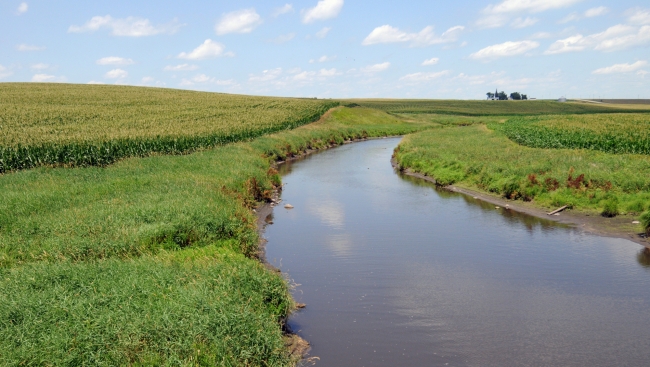Francis Thicke is a soil scientist and organic dairy farmer. He has served as the National Program Leader for Soil Science for the USDA-Extension Service and was the 2010 Democratic candidate for Iowa secretary of agriculture. -promoted by desmoinesdem
I submitted the following op-ed to the Des Moines Register, but the newspaper did not print it.
In a recent guest column for the Register, Iowa Secretary of Agriculture Mike Naig presented the usual ag-lobby refrain that Iowa’s nitrate problem is caused by the weather. It is time for Iowa’s citizens to stop listening to this kind of misinformation and learn about the real cause of our nitrate problem, and how we can solve it.
High nitrate levels in Iowa’s rivers have one basic cause: our predominant cropping system–corn and soybeans–is fundamentally flawed. It is inherently leaky of nitrate.
It is inherently leaky because corn and soybeans are annual crops that have live roots in the soil for only about five months of the year. During most of the year, there are no live roots in the soil to remove and utilize the soluble nitrate that travels with rainfall down to field tile drainage systems and on to our rivers.
It is time to stop pretending that rain is the cause of our nitrate problem. Nitrate pollution of our rivers is inevitable under corn and soybean cropping systems without remedial conservation measures, such as the use of cover crops. And since two-thirds of Iowa’s total land surface is covered with corn and soybeans, it should be no surprise that our rivers are polluted with nitrate. Yes, heavy rainfall events will increase nitrate leaching under some conditions, but heavy rainfall events are to be expected. Blaming our nitrate problem on the weather is disingenuous.
Iowa’s pattern of cropping systems is a water quality problem waiting to happen.
Research shows that perennial crops, as well as cover crops that are planted to grow during the off season of corn and soybean production, can dramatically reduce nitrate leaching and loss to our rivers. Those crops provide roots in the ground during times when corn and soybeans are not growing. Those crops scavenge soil nitrate before it reaches the field tile drainage system. Unfortunately, only about two to three percent of Iowa’s cropland is planted to cover crops each year.
As the June 22 Des Moines Register article by Donnelle Eller pointed out, “Nitrogen pollution flowing out of Iowa to the Gulf of Mexico has grown by close to 50 percent over nearly two decades […] despite hundreds of millions of dollars spent to stem nutrients entering the state’s waterways.” Our investments are not paying off. We need a new approach.
There is one straightforward way to solve our water quality problem: require every farm in Iowa to implement a water quality plan that addresses the specific water quality concerns for each farm.
We now have sufficient water quality research data to be able to estimate the expected loss of nitrate and phosphorus from farm fields for various combinations of farming practices. As with the Universal Soil Loss Equation, which predicts soil loss for various farming practices, we could use our water quality database to create a water quality computer model that will predict nitrate and phosphorus loss from any farm field based on the field’s cropping and conservation practices. That water quality model could be used to create farm-level water quality plans.
Farm water quality plans would give every farmer the flexibility to choose farming and conservation practices that fit his or her farming operation, as long as each farm field met the tolerance levels for nitrate and phosphorus loss to our water resources. Tolerance levels for nitrate and phosphorus should be based on the statewide goals of Iowa’s Nutrient Reduction Strategy, which calls for Iowa agriculture to reduce nitrogen loss by 41 percent and phosphorus loss by 29 percent.
Iowa’s voluntary water quality approach is not working. A flexible, science-based regulatory approach–like a mandatory water quality plan for every farm–is needed to solve our water quality problems.
Francis Thicke of Fairfield is a farmer and soil scientist and has served as the National Program Leader for Soil Science for the USDA-Extension Service.


1 Comment
Thank you, Francis Thicke
I’m grateful to be able to read this good piece in BLEEDING HEARTLAND. I wish that every Iowan, besides reading Dr. Thicke’s good essay, could watch a good slake test comparing healthy soil under perennial vegetation with unhealthy compacted soil under rowcrops. That kind of test is a two-minute mind-blowing illustration of where Iowa’s soil and water problems really come from.
As for Mike Naig’s exercise in evasion, Dr. Thicke was more polite toward it than it deserved.
PrairieFan Fri 27 Jul 2:36 AM